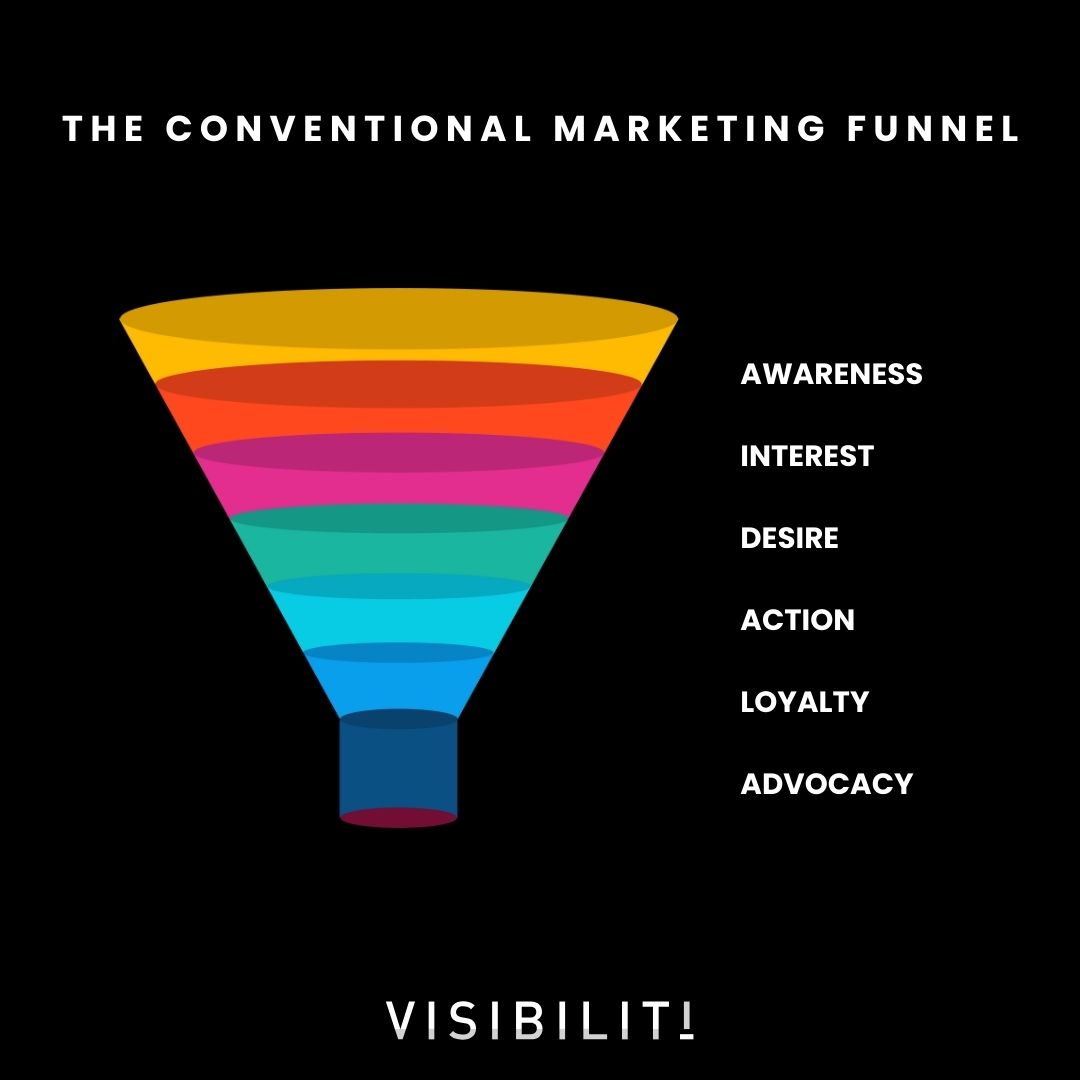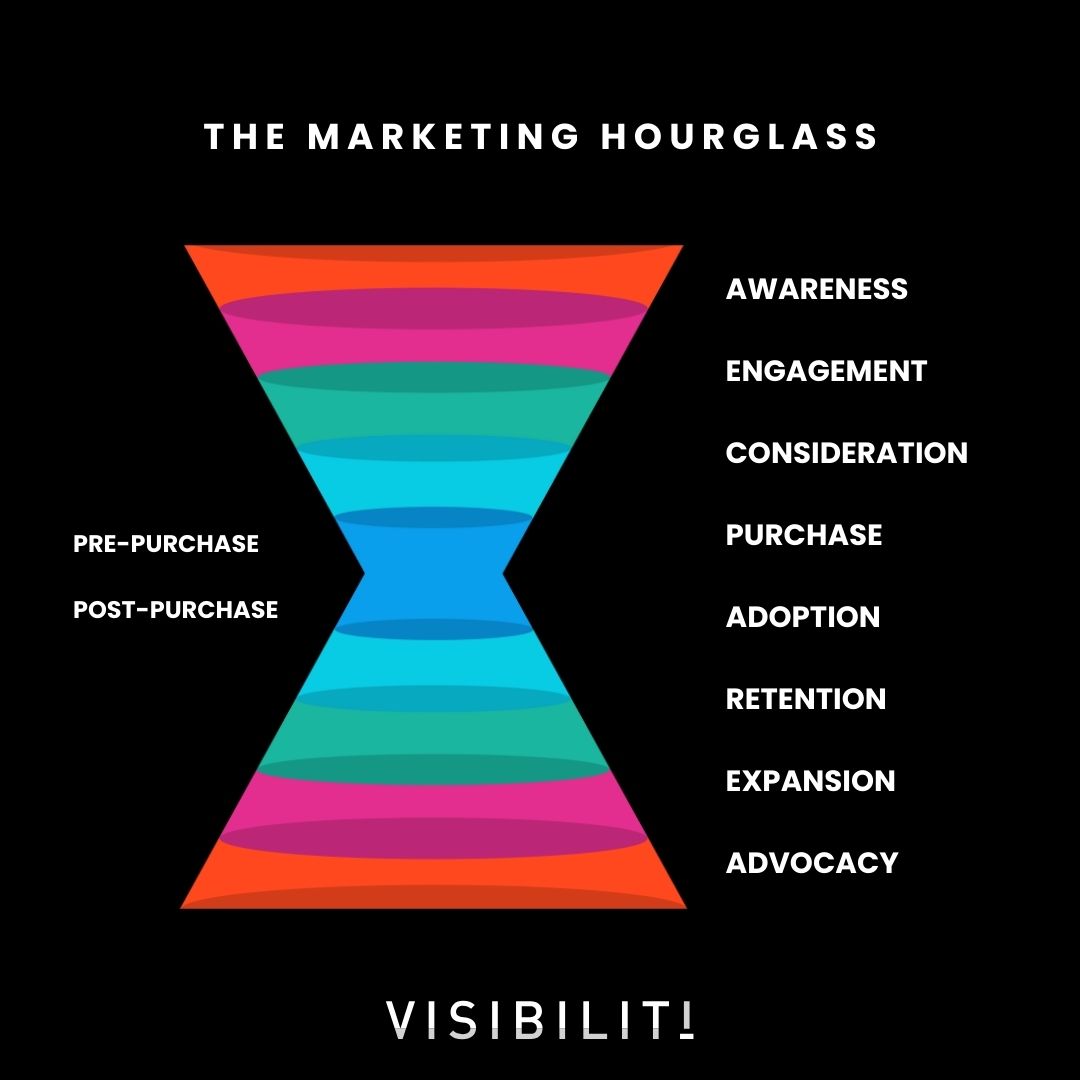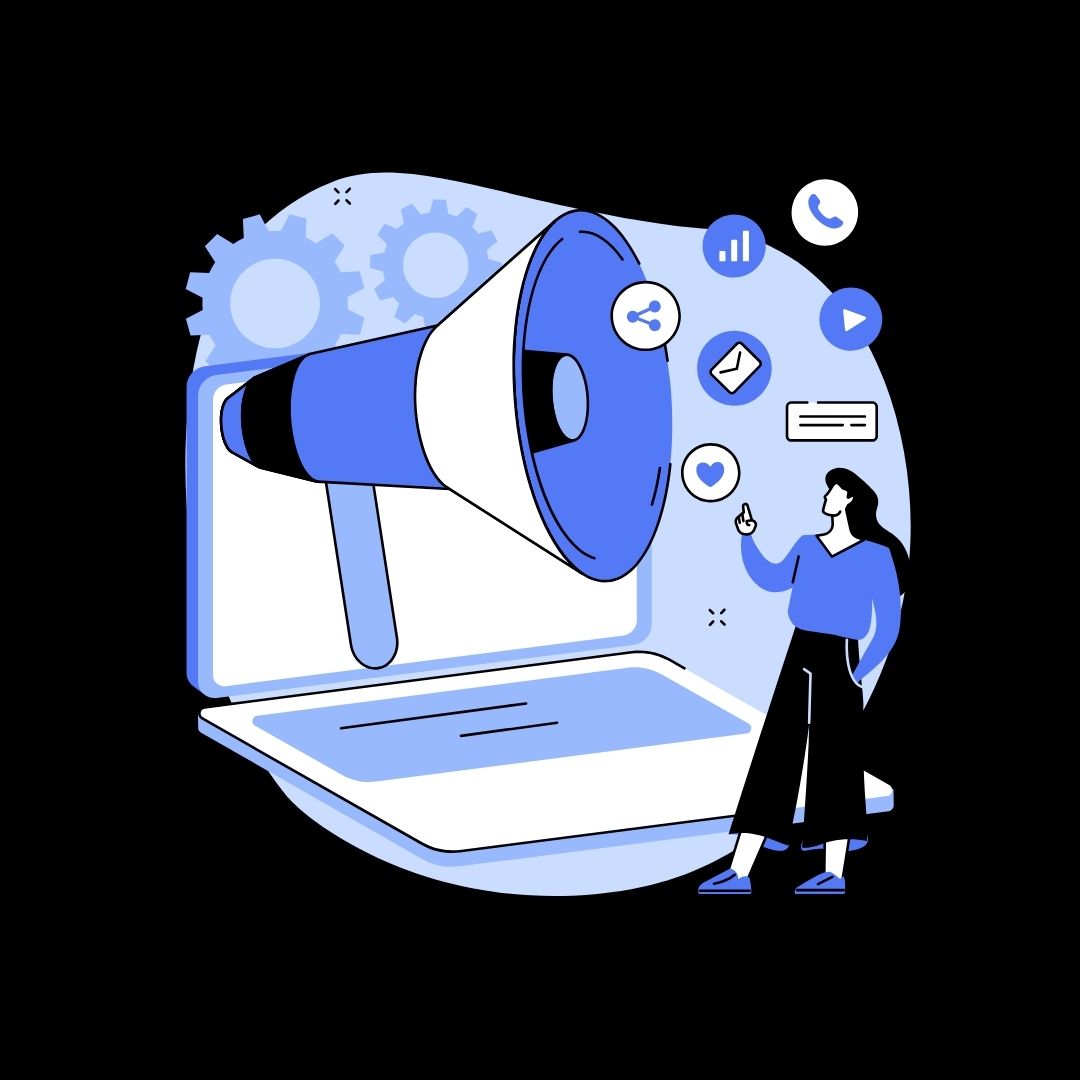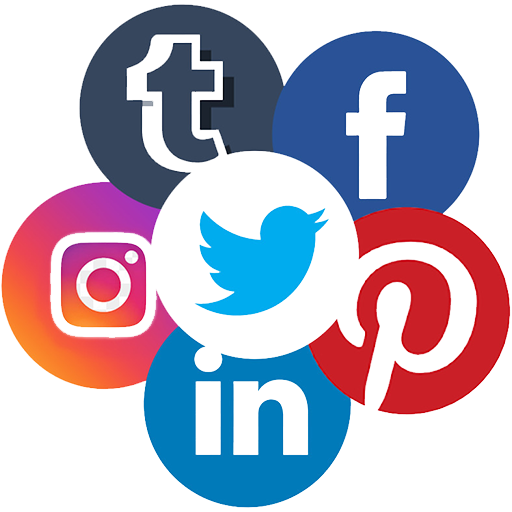Business owners and marketers are familiar with the marketing funnel, also known as the customer purchase cycle, sales funnel, or conversion funnel.
It tells you what your company must do to influence customers at different stages. By evaluating your funnels, you can potentially drive greater sales, more loyalty and stronger brand awareness.
What is the Conventional Marketing Funnel?
The marketing or purchasing funnel, is a consumer-focused marketing model that depicts the theoretical customer journey toward the purchase of a good or service.
People / customers naturally drop out at each stage because not everyone will become a customer. This creates the funnel shape.

Awareness / Exploration: The prospect is aware of their problems and possible solutions for them.
Interest: The prospect shows interest in a group of services or products. The prospect is looking to fulfil a desire or need.
Desire / Consideration: The prospect begins to evaluate a certain brand, finding out more about the brand and the product.
Action / Conversion: The prospect decides whether to purchase. The prospect becomes a customer after purchase.
Loyalty / Retention: The customer uses the product or service, is satisfied and likes it, and chooses the brand repeatedly. The brand actively engages with the loyal customer through personalised communication, loyalty programmes and good customer service.
Advocacy / Recommendation: The loyal customer believes in the product or brand so much and recommends it to others (new lead generation). Actively advocates for the brand whether organically or as a recognised advocate and deepens the relationship between brand and customer.
Opinions on the Conventional Marketing Funnel
The conventional marketing funnel has its flaws. It presumes that your job ends once a customer makes a purchase—but in reality, that’s just the beginning of building a sustainable, thriving business.
Though the conventional marketing funnel model has been a foundational tool in understanding customer journeys, it has faced significant criticisms in the digital age and 2020s.
1. Change in the Digital Customer Journey
Traditional funnels assume a linear path from awareness to purchase. However, modern consumer journeys are more dynamic. With digital platforms, customers can enter or exit at various stages, revisit earlier stages, or skip steps entirely before purchase.
2. Non-linear Engagement
Social media and digital touchpoints allow for diverse interactions, such as direct purchases from social ads or reviews influencing decisions pre-awareness. This behavior disrupts the predictable flow of the marketing funnel.
3. Neglect of Post-Sale Experience
Traditional models focus heavily on acquisition and conversion, often sidelining the importance of retention, loyalty, and advocacy.
In today’s customer-centric landscape, nurturing post-sale relationships is crucial for building loyalty and driving word-of-mouth marketing.
4. Fragmentation of Marketing Channels
The rise of omnichannel interactions means customers might engage with a brand through multiple platforms simultaneously, blurring the linear boundaries of the funnel.
5. Consumer Control
Digital transparency and access to information give consumers more control over their buying decisions, making them less reliant on the traditional funnel.
Say Hello to the Marketing Hourglass
Businesses must rethink their approach, particularly in Singapore’s competitive and digitally driven market. Brands that succeed aren’t just acquiring customers; they’re creating robust systems to maximise customer lifetime value (CLV) while fostering loyalty and advocacy.
So let’s imagine your marketing strategy as an hourglass instead of a funnel. This model emphasises the entire customer journey, from early awareness to the highest level of advocacy, ensuring sustainable growth.

Mastering the Essentials – The Top Half of the Hourglass
The upper half of the hourglass mirrors the classic funnel stages. Singaporean businesses, particularly SMEs, can leverage this framework to establish strong foundations:
Awareness: Capturing Attention in Singapore’s Dynamic Market
- Utilise hyper-localised content marketing to resonate with diverse demographics.
- Invest in targeted SEM digital ads across platforms like Google, Facebook, and TikTok, where Singaporean audiences are most active.
- Build partnerships with influencers and micro-influencers who reflect Singapore’s vibrant culture.
- Supplement with SEO strategies to bolster your business website and grow organic channels.
Engagement: Building Connections That Stick
- Craft value-driven storytelling that aligns with Singapore’s values and your brand, such as innovation, resilience, cultural and community support, inclusivity, sustainability and more.
- Leverage user-generated content (UGC), a powerful way to engage Singaporean customers who value authenticity.
- Introduce gamified or interactive content (giveaways, polls, challenges etc), which appeal to Singapore’s digitally savvy population.
Consideration: Educating and Earning Trust
- Share transparent pricing and comprehensive comparisons to assist in informed decision-making—Singaporeans value clarity especially on prices and costs.
- Highlight testimonials from local customers and case studies to build credibility.
- Utilise social proof on popular review platforms like Google / Facebook Reviews.
Purchase: Streamlining the Decision
- Provide seamless checkout experiences through Singapore-preferred payment methods, such as Scan to Pay, PayNow or digital wallets.
- Offer tailored promotions or incentives, like free trials, discounts on the first purchase for new customers or free local shipping.
- Utilise urgency if items have limited availability – note: do not fake this information or you’ll look dishonest.
- Optimise your website for mobile screens, considering the high mobile penetration rate in Singapore.
The Growth Engine – The Bottom Half of the Hourglass
Here’s where the hourglass transforms marketing into a long-term growth strategy for businesses:
Adoption: Elevating First Impressions
- Offer localised onboarding materials, such as multilingual guides tailored for Singapore’s multiracial population (minimally English, Mandarin, Malay and Tamil languages).
- Teach your customers how to use your products and services.
- Send automated follow-up emails with quick-start videos to enhance post-purchase satisfaction.
- Engage and conduct post-purchase polls to capture customer sentiment and address potential issues immediately with subsequent follow-ups.
Retention: Turning One-Time Buyers Into Loyal Customers
- Introduce loyalty programmes with personalised rewards, such as discounts for frequent purchases or exclusive VIP customer perks.
- Use automated email flows to suggest seasonal or event-specific products, like deals for Chinese New Year or National Day.
- Leverage retargeting ads to re-engage customers who haven’t purchased in a while.
Expansion: Driving Revenue Through Upselling and Cross-Selling
- Use AI-powered product recommendations to showcase complementary items based on past purchases.
- Based on collected popular purchase data, bundle products that cater to Singaporean-specific needs, like eco-friendly bundles or tropical skincare kits.
- Offer exclusive limited-edition products or services to your most loyal customers.
Advocacy: Amplifying Your Reach Through Satisfied Customers
- Encourage satisfied customers to leave reviews on your website and on local platforms, such as Shopee or Carousell, which are popular in Singapore.
- Launch referral programmes that incentivise customers with vouchers, discounts or gifts for bringing in new customers through referral.
- Spotlight customer success stories on your social media channels to foster a sense of community.
- Continued engagement with loyal customers on all platforms.
Why the Hourglass Model is Perfect for Singapore Businesses

Singapore’s unique market dynamics demand strategies that go beyond customer acquisition. The hourglass approach thrives in this environment because:
Higher CLV (Customer Lifetime Value)
Singaporean customers, once loyal, are more likely to make repeat purchases if the experience is seamless with multiple benefits.
Cost-Effective Growth
Advocacy and referrals help reduce dependency on high digital ad costs in Singapore’s competitive ad space.
Reduced Churn
Strong post-purchase engagement ensures customer retention, which is critical in a market saturated with options.
Talk to Us About Digital Marketing
Future Trends in the Evolution of the Marketing Funnel
The marketing funnel is undergoing significant transformation, driven by technological advancements and shifting consumer behaviours.

Here are some key future trends:
-
Shift to Experience-Centric Models (UX and UI)
The focus is moving from merely driving conversions to fostering long-term relationships and loyalty through exceptional post-sale experiences where the customer experience is key.
Models must be dynamic to account for non-linear, omnichannel consumer behaviours and engagement across touchpoints.
-
Sustainability and Ethical Marketing
Consumers increasingly expect brands to align with their values. Future funnels will likely incorporate storytelling that highlights social responsibility and environmental impact.
-
Automation and Efficiency
Marketing Automation tools powered by AI will streamline repetitive tasks, enabling marketers to focus on strategy and creativity. Chatbots and Virtual Assistants will play a larger role in guiding customers through their journeys, offering support and recommendations in real-time.
-
Real-Time Analytics and Optimisation
Advanced analytics tools will allow marketers to monitor performance in real time and adjust campaigns instantly, ensuring resources are optimised for maximum impact.
These trends point to a future where the marketing funnel is more adaptive, personalised, and focused on creating meaningful, long-lasting relationships with customers.
By evolving beyond the funnel, brands can better align with today’s digital and dynamic customer expectations.
Get Started with Marketing Analytics and Automation
Key Takeaways in Implementing the Marketing Hourglass
The traditional marketing funnel isn’t dead—it’s just incomplete. By flipping the funnel into an hourglass, Singapore businesses can unlock the full potential of their customer base.
Some Focus Areas for Singaporean Businesses:
- Invest in post-purchase engagement to transform buyers into advocates.
- Leverage Singapore’s digital-first culture with tools like automation to personalise experiences.
- Build loyalty programmes and referral systems to drive organic growth and reduce new customer acquisition costs.
The marketing hourglass provides a model for you to analyse and improve your marketing strategies at each stage. Keep on experimenting, and you’ll find ways to improve your results.
Your best customers aren’t the ones you acquire; they’re the ones who stay—and keep coming back.
Let’s Chat About Digital Marketing for Your Business
Related Posts
Achieve your business goals with qualified leads and sales through Digital Marketing

All
Articles
All Articles

Digital Marketing
Digital Marketing

Business Insights
Business Insights

TikTok Marketing
TikTok Marketing

Search Engine
Marketing (SEM)
Search Engine Marketing (SEM)

Search Engine
Optimization (SEO)
Search Engine Optimization (SEO)

Social
Media Marketing (SMM)
Social Media Marketing (SMM)
